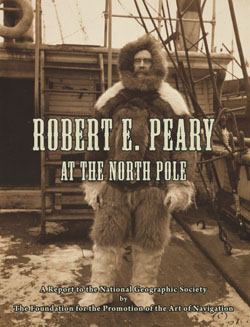 |
 |
 |
||||
|
Robert Peary at the North Pole By Thomas D. Davies
ISBN 9780914025207
$19.95 ...item# 1988
|
 |
|
On September 6, 1909, then Commander Robert E. Peary announced that he and his long time assistant Matthew Henson, along with four young Inuit men, Ootah, Egingwah, Seegloo, and Oogueah had reached the North Pole by dog sled on April 6, 1909. Logistical support of this intricately planned expedition was coordinated by Capt. Bob Bartlett, skipper of Peary’s ship, the Roosevelt, along with a select crew of scientists and explorers, a large contingent of Inuit men and women, and 133 sled dogs. It was an accomplishment Peary had devoted 23 years of his life to.
Peary and Henson have since gone down in history as the “discoverers” of the North Pole, but the difficulties in achieving this credit extended far beyond the end of the expedition itself. From the very beginning there have been skeptics of this achievement and numerous assaults on Peary’s integrity. The challenge was initially fueled by a completely forged claim of an earlier discovery by Dr. Frederick Cook, a former surgeon on one of Peary’s expeditions, who had deceived much of the public and several influential persons into believing he had been to the Pole earlier than Peary. Even after it was unambiguously established that Cook’s claim was fraudulent, damage to Peary’s cause had been done. Politics and personalities of the central figures overshadowed clear reasoning in much of the debate. As the renown Arctic explorer Dr. Vilhjalmur Stefansson put it at the time “Cook was a liar and a gentleman; Peary was neither.” There followed a relentless string of accusations against Peary, each based on a lack of knowledge of the expedition and of the navigation techniques involved. Even today, it remains easier to find in print and online more doubts about Peary’s accomplishment than informed analysis and praise for it. The persistence of this misinformation is in large part because this book has not been more readily available. This research by professional navigators and scientists laid to rest the question, once and for all, that Peary did indeed reach the Pole as he claimed. Each aspect of the navigation and travel are analyzed, and the details are presented here. As shown in a new Supplement, even subsequent challenges to this report itself have been readily dispelled.
Many of Peary's accomplishments are documented at the Peary-MacMillan Arctic Museum at Bowdoin College in Brunswick, Maine. |
|
